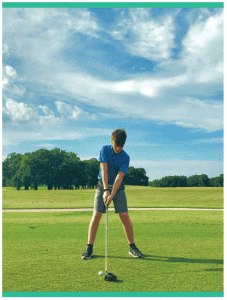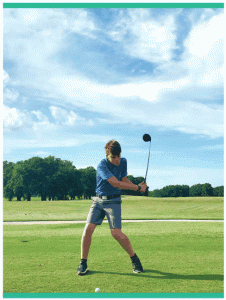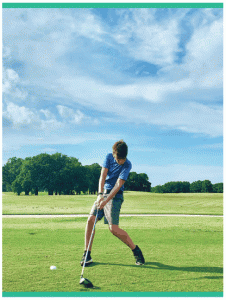Blog
News From China
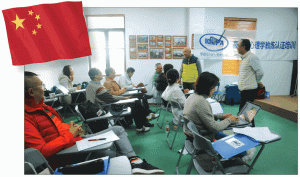 By Toby Tse, USGTF-China Representative
By Toby Tse, USGTF-China Representative
We Conducted the first USGTF International Golf Psychology Association certification and training course on March 19 and 20. Training started at 8:30 a.m. and finished at 6:30 p.m., 10 hours each day. It covered the five sections, including all the drills and tests. Each section took approximately 3 1/2 hours to complete, with 2 1/2 hours teaching, a half-hour working on drills, and a half-hour on test papers.
Ten candidates registered and nine attended, with one missing due to work. Eight candidates passed and got certified, with one who failed and is attending the next course, including the no-show candidate.
 The two-day course was quite heavy and tight in timing. The students were loaded with tons of materials and information. We taught with a PowerPoint presentation of some 200 slides covering bullet points, and a hard copy handout of the full content was given to each student, with some 60 pages printed on both sides. The course was conducted in the Chinese language.
The two-day course was quite heavy and tight in timing. The students were loaded with tons of materials and information. We taught with a PowerPoint presentation of some 200 slides covering bullet points, and a hard copy handout of the full content was given to each student, with some 60 pages printed on both sides. The course was conducted in the Chinese language.
It took us more than two years to prepare the course. The most time-consuming jobs were the Chinese translation and preparation of the PowerPoint slides, where we had to pick the key points which were bell-ringing and had to search the pictures and photos for all the names mentioned. Due to cultural differences and the late start of golf in China, most Chinese students had no idea of those who were featured, including U.S. presidents, ancient philosophers, sport psychologists, famous sport coaches, and the older generation of golfers, even though they were in the Hall of Fame and had substantial influence and achievements. We had to show them the photos, histories and achievements of these people so that they would accept them as credible sources.
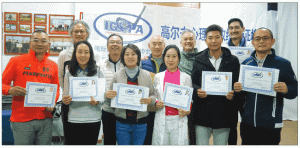 Conclusion – the course is well organized and prepared with valuable information and insight to prepare the attendees to be better players and coaches, and to re-engineer the way they think, play and teach.
Conclusion – the course is well organized and prepared with valuable information and insight to prepare the attendees to be better players and coaches, and to re-engineer the way they think, play and teach.
Due to cultural differences, we will be making some changes to the program, including mentioning some Chinese golfers. In any case, we won’t make drastic changes and will keep the original context and framework in its totality.
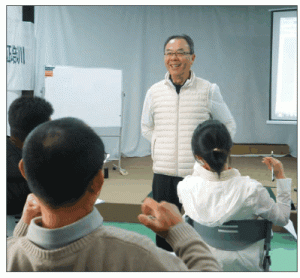
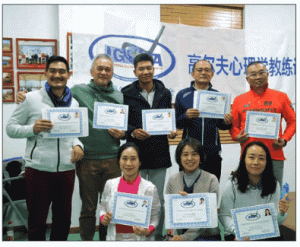
Golf In Korea
 Brandon Lee, president of USGTF-Korea, hosted the USGTF-Korea National Awards 2018 dinner on December 16, 2018. He invited 50 people who have been the most dedicated to the development of the USGTF-Korea federation and the Korean golf industry for 2018. He also awarded the 2018 Achievement Award of USGTF-Korea to two winners, the Certificate of Recognition for Top 10 Teachers of USGTF-Korea for 2018 and the 2018 Best Teacher Award.
Brandon Lee, president of USGTF-Korea, hosted the USGTF-Korea National Awards 2018 dinner on December 16, 2018. He invited 50 people who have been the most dedicated to the development of the USGTF-Korea federation and the Korean golf industry for 2018. He also awarded the 2018 Achievement Award of USGTF-Korea to two winners, the Certificate of Recognition for Top 10 Teachers of USGTF-Korea for 2018 and the 2018 Best Teacher Award.
Seoung Gweon Choi, professor of Yong In University, and Hyun Jeong Kang, attorney of Kim & Shin, were selected for the 2018 Achievement Award of USGTF-Korea, and Woo Hyun Kwon, Kyung Sick Kim, Woo Tae Kim, Ki Beom Park, Cheol Hee Park, Kyong Soo Seok, Kwang Bok Shin, Woo Jae Jeong, Hae Kyeong Choi and Yoon Sang Hwang were selected for the Top 10 Teachers of USGTF-Korea for 2018. Cheol Hee Park was selected for the 2018 Best Teacher Award of USGTF-Korea.
Lee plans to continue this annual event so that it will become a tradition of USGTF-Korea and become a place to encourage those who contribute to the development of the Korean golf industry as well as the USGTF- Korea Federation.
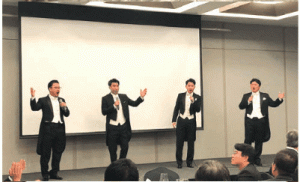


1994-2019…Celebrating 25 Years!
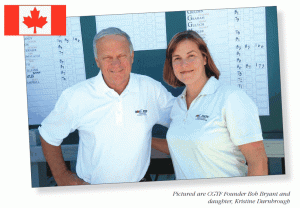 It has been 25 great years growing the game of golf in Canada! Times have changed and so have we. Reflecting back on how our federation grew and competed before the regular use of the internet and social media is astonishing. The administration team of Bob Bryant and Kristine Darnbrough, along with our pioneer members and wonderful facilitators, truly deserve a great “thank you” for their efforts, support and contributions!
It has been 25 great years growing the game of golf in Canada! Times have changed and so have we. Reflecting back on how our federation grew and competed before the regular use of the internet and social media is astonishing. The administration team of Bob Bryant and Kristine Darnbrough, along with our pioneer members and wonderful facilitators, truly deserve a great “thank you” for their efforts, support and contributions!
Rounds played are up in Canada, and the overall participation has grown over the past few seasons after some difficult economically affected years. Canada boasts the largest percentage of population that plays golf at least once a year worldwide. So, golf in Canada is still pushing forward. The members of the Canadian Golf Teachers Federation are enjoying new opportunities and successes in the industry, thanks to golf facility operators seeking new alternatives to traditional practices. Our members’ passions and efforts are helping to re-energize facilities that have been burdened with outdated thinking and elitism that prevents new customers from feeling welcome, let alone encouraged to start.
Canada is very diverse in many ways and so is the CGTF. We have many instructors that communicate using languages beyond English and French. Lately, the CGTF certification schools have been very appealing to international participants to attend. Having a lower-trading Canadian dollar and attainable travel visas make Canada a very attractive destination to pursue a career in teaching golf. We are proud to think that we are now sharing golf in places that have no access to Golf Teachers Federation training locally.
In this 25th year, the top indicator of membership engagement has been the positive response to upgrade courses. Knowing and seeing our members wanting more information to pass along has been a welcome site. We have more Masters-level graduates this year than the past 10 years combined, and we have one more course to follow in August 2019. Golf in Canada is going very well, and the CGTF sends best wishes to all fellow World Golf Teachers Federation members!
Harman Back On Top In Southeast
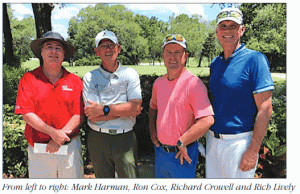 Mark Harman made a statement that he is still a force to be reckoned with at GlenLakes Country Club in Weeki Wachee, Florida, this past May. The reigning World Cup champion from Ridgeland, South Carolina, set a Southeast Region Championship scoring record of seven under par to best Ron Cox of Henderson, Tennessee, by five shots. Richard Crowell from Pensacola, Florida, and Rich Lively of Rockledge, Florida, took third and fourth, grabbing the balance from the $1,200 purse. Thanks goes out to GlenLakes head pro Tom McCrary, who has hosted us for several years.
Mark Harman made a statement that he is still a force to be reckoned with at GlenLakes Country Club in Weeki Wachee, Florida, this past May. The reigning World Cup champion from Ridgeland, South Carolina, set a Southeast Region Championship scoring record of seven under par to best Ron Cox of Henderson, Tennessee, by five shots. Richard Crowell from Pensacola, Florida, and Rich Lively of Rockledge, Florida, took third and fourth, grabbing the balance from the $1,200 purse. Thanks goes out to GlenLakes head pro Tom McCrary, who has hosted us for several years.
Abraham’s Team Wins League Title, Tournament
 USGTF member Walt Abraham, head golf coach of Athenian High School in Danville, California, led his squad to the BCL-East league round-robin regular season title and also the league post-season tournament title. The team finished 9-1 in match play and next heads to the Division 2 championship tournament. The league title marks the seventh time in Abraham’s 11 seasons as head coach that Athenian has taken that honor. Athenian fields a young squad of three freshmen, one sophomore and two juniors, with three players earning all-league honors.
USGTF member Walt Abraham, head golf coach of Athenian High School in Danville, California, led his squad to the BCL-East league round-robin regular season title and also the league post-season tournament title. The team finished 9-1 in match play and next heads to the Division 2 championship tournament. The league title marks the seventh time in Abraham’s 11 seasons as head coach that Athenian has taken that honor. Athenian fields a young squad of three freshmen, one sophomore and two juniors, with three players earning all-league honors.
Golden Repeats As Southwest Regional Champion
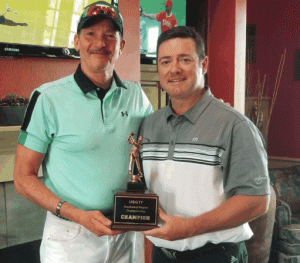 Cole Golden shot an opening round 69 against a strong field that featured several current and past USGTF champions at a windy Ridgeview Ranch Golf Course, which hosted the USGTF Southwest Region Championship May 4-5 in Plano, Texas. Tough, tricky greens and somewhat wet conditions after several days of wet weather had hit Texas earlier in the week greeted the competitors. Southwest Region director Bruce Sims and Master Lee carded 76 the first day, while Brent Davies and Chris Tyner shot 77. Grant Gulych, Jeff Kennedy, and D.B. Merrill came in with 78.
Cole Golden shot an opening round 69 against a strong field that featured several current and past USGTF champions at a windy Ridgeview Ranch Golf Course, which hosted the USGTF Southwest Region Championship May 4-5 in Plano, Texas. Tough, tricky greens and somewhat wet conditions after several days of wet weather had hit Texas earlier in the week greeted the competitors. Southwest Region director Bruce Sims and Master Lee carded 76 the first day, while Brent Davies and Chris Tyner shot 77. Grant Gulych, Jeff Kennedy, and D.B. Merrill came in with 78.
Golden continued his fine play on day two and was never threatened, as only Davies was able to get within three shots on the back nine before Golden responded with a birdie on the next hole. Golden finished with a 69-74 – 143 for a 1-under-par total. Davies finished in second place after shooting 70, which was the low round of the day, for a 147 total. Lee played solidly all day after shooting a fine round of 74 for a 150 total, coming in third place. Canadian Gulych finished in fourth place 78-77 – 155; Texas’ Tyner finished in fifth place with 77-80 – 157; Ruben Ramirez finished sixth with 83-75 – 158; Merrill finished seventh with 78-82 – 160, and Jeff Kennedy finished eighth at 161. Thanks goes out to all USGTF players who participated, especially Jim Peters, Craig Johansen, Jaejin Kim, Kevin Kim, Jihun Yang, Scott Lundgren and J.D. Winkle.
Sims also hosted a very nice pre-tournament dinner on Friday night, where there were lots of camaraderie and discussion about our great game. USGTF players came from Kansas, Kentucky, Oklahoma, Michigan, Ontario Canada, and several parts of Texas to play in this fine event.
Junior Camps and the Evolution of The Instructor
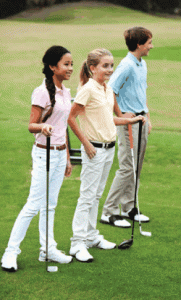 By Graham Lewis, USGTF Teaching Professional Townsend, Georgia
By Graham Lewis, USGTF Teaching Professional Townsend, Georgia
My first introduction to the USGTF was in the fall of 2009. I met a gentleman on the practice range at Sapelo Hammock Golf Course in Shellman Bluff, Georgia, where I worked part time in the pro shop. After a few exchanges on the art of the golf swing, he explained that he was a teaching professional at a country club in Vermont. His name is Alan Jeffery and he received his Master Golf Teaching Professional certification from the USGTF. Alan convinced me to consider learning more about the USGTF.
The certification course at Jones Creek Golf Course in Augusta, Georgia, was led by Mark Harman. During the five days of the course, I be-came confident that my knowledge of the Golfswing was good until Mark asked me, in the verbal final, what would I do with a student with a chicken wing. My answer will remain unpublished but a passing grade was received.
Once back at Sapelo Hammock, the owners of the club at that time gave me the go ahead to establish a golf academy. Along with one-on-one instruction, my first priority was starting a junior camp program during the summer months. The first junior camp had six kids ranging in ages from 8 to 13. Instruction was provided by me, the only instructor at the time. During the four half-days of the camp, each junior received instruction in all aspects of the game, with emphasis on the four basic fundamentals: grip, posture, alignment and ball position.
All instruction was confined to the putting green, chipping green and practice range, and clubhouse question-and-answer sessions were held during the only water break of the three-hour session. The only training aid used was an alignment rod. Each junior was given a three-ring binder which included pictures and explanations on every part of the game. My sources were Golf Magazine, Ben Hogan’s Five Lessons: The Modern Fundamentals of Golf and the USGTF’s first edition of How To Teach Golf.
At the close of camp, each junior proudly demonstrated their knowledge of the basic fundamentals and received a camp picture and a certificate.
Since that first camp, attendance has grown to between 25 and 30 kids for each camp in June and July. Additional instructors have been added, and the range of ages has expanded to 5 to 16. Juniors are divided into three groups based on age. One group will be on the putting green, while another is on the chipping green and another on the practice range. Each group changes location every45 minutes after a water break in the clubhouse, where prizes are given during question-and-answer sessions. The highlight of the camp is the last day, when everyone plays a nine-hole scramble with their parents and grandparents driving the carts. A lot has been learned these past eight years on how to run a successful camp.
In summary, the changes to the original camp of 2012 are:
- To satisfy demand, the range of ages has increased to 5-16.
- With the increase in camp sizes, we now have three groups of juniors based on age.
- Each camp now has a higher percentage of girls participating.
- Parents and grandparents are encouraged to watch.
- The kids are given two water breaks instead of one.
- Question-and-answer sessions have been expanded to include more questions from the kids rather than just from the instructors.
- Playing a scramble with parents and grandparents driving the carts. Early camps had younger kids playing with older kids. We now try to have teams divided by age and ability.
- Numerous training aids have been added, and target signs have been used at close range on the practice area (similar to the TV show “Big Break,” where they broke the glass).
- Volunteers for control and safety have been added, especially for the younger kids.
- I have become more open to new ideas. The three-ring binder has been replaced by the Bob Dimpleton book Golf 101. This cartoon version of learning how to play golf is a great hit with the younger kids. Another example is when I expressed skepticism at a suggestion to include a short-course layout using foam balls and a hula hoop for a hole. At first I considered it to be too “Mickey Mouse,” but then I remembered at 16 years of age I learned to play in my backyard with a wiffle ball and soup can for a hole. My only instruction came from Hogan’s Five Lessons book and a mirror. The short course is a big hit.
Mark and I have become good friends ever since he explained to me what a chicken wing was.
The one thing that has remained constant from the first camp and every one since is that safety, fun, and instruction, in that order, remain the priority.
Like America and Apple Pie…It’s Golf and Family Ties
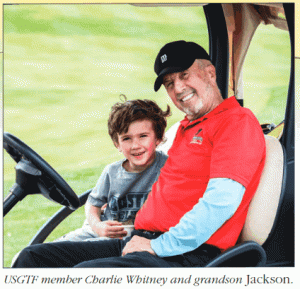 What are the first memories that you have of golf? If you started the game as a kid, they probably have to do with a family member – usually a parent – who introduced the game to you. Many golfers look back on those days with great fondness and nostalgia.
There is no better family sport than golf. Four family members can all play in the same group, something that is difficult to do in other sports. You can indeed do the same thing in tennis if you’re playing doubles, but unless the skill level is relatively similar among the four, it can make for a difficult time. Since golf, of course, doesn’t have other players affecting your playing of the game, it doesn’t matter if there is a skill disparity, even a great one, among those in the same group.
Golf also has an amount of down time that others sports do not offer. In tennis, there is constant action. In bowling, there is always someone rolling the ball down the lane. But in golf, most of the time is spent walking or riding to the next shot, so there is ample time for conversation and bonding. Some of the best friendships golfers have were formed on the golf course. Indeed, it’s not uncommon for golfers to have mainly or only golfers as friends.
The game also tends to lend itself to easy conversation that may not be found in other venues. Those who are parents know how tough it is sometimes to have conversations with their children as they get older, especially teenagers. But for some reason, conversation while playing golf seems to come naturally for most participants.
It has been said countless times that golf is also a metaphor for life. A well-known adageis that if you want to truly get to know a person’s character, play 18 holes of golf with them. It is the rare person who changes the character and behavior they exhibit outside the course once they step onto the first tee.
Life lessons can also be imparted to our younger family members as they play the game. Perhaps a child is having a tough time that day on the course and they feel like quitting. Teaching them to persevere on the course is a good lesson that can carry them through life. Let’s face it – although we say golf is fun, it’s also difficult to excel at. If someone wants to play scratch golf or better, they have to put in countless hours over countless days over countless years, unless they are some sort of athletic freak. Golf can teach our children the valuable life values of determination and perseverance, and keeping a calm mind when things go awry.
Although the game can understandably lend itself to temper tantrums and worse, we must always remember that unless the game directly affects our well-being as a professional golfer, it’s only a game to the rest of us. How we do doesn’t affect our lives in any way, shape, or form, and it’s important to keep this perspective. These are the things that our younger family members, and sometimes even ourselves, should take to heart.
What are the first memories that you have of golf? If you started the game as a kid, they probably have to do with a family member – usually a parent – who introduced the game to you. Many golfers look back on those days with great fondness and nostalgia.
There is no better family sport than golf. Four family members can all play in the same group, something that is difficult to do in other sports. You can indeed do the same thing in tennis if you’re playing doubles, but unless the skill level is relatively similar among the four, it can make for a difficult time. Since golf, of course, doesn’t have other players affecting your playing of the game, it doesn’t matter if there is a skill disparity, even a great one, among those in the same group.
Golf also has an amount of down time that others sports do not offer. In tennis, there is constant action. In bowling, there is always someone rolling the ball down the lane. But in golf, most of the time is spent walking or riding to the next shot, so there is ample time for conversation and bonding. Some of the best friendships golfers have were formed on the golf course. Indeed, it’s not uncommon for golfers to have mainly or only golfers as friends.
The game also tends to lend itself to easy conversation that may not be found in other venues. Those who are parents know how tough it is sometimes to have conversations with their children as they get older, especially teenagers. But for some reason, conversation while playing golf seems to come naturally for most participants.
It has been said countless times that golf is also a metaphor for life. A well-known adageis that if you want to truly get to know a person’s character, play 18 holes of golf with them. It is the rare person who changes the character and behavior they exhibit outside the course once they step onto the first tee.
Life lessons can also be imparted to our younger family members as they play the game. Perhaps a child is having a tough time that day on the course and they feel like quitting. Teaching them to persevere on the course is a good lesson that can carry them through life. Let’s face it – although we say golf is fun, it’s also difficult to excel at. If someone wants to play scratch golf or better, they have to put in countless hours over countless days over countless years, unless they are some sort of athletic freak. Golf can teach our children the valuable life values of determination and perseverance, and keeping a calm mind when things go awry.
Although the game can understandably lend itself to temper tantrums and worse, we must always remember that unless the game directly affects our well-being as a professional golfer, it’s only a game to the rest of us. How we do doesn’t affect our lives in any way, shape, or form, and it’s important to keep this perspective. These are the things that our younger family members, and sometimes even ourselves, should take to heart.
The lessons children learn on the golf course, from perseverance to patience, often mirror the lessons they need in everyday life. Struggles, mistakes, and frustrations become opportunities to build character and resilience, while the calm moments teach them the value of focus and perspective. Families that encourage these lessons create stronger bonds by showing children that success isn’t about perfection but about growth and effort. In many ways, games like golf become metaphors for life itself, reminding us all that setbacks are temporary and persistence leads to progress.
Just as these life values are nurtured within families, there are also moments when families face challenges that require guidance beyond what love and patience alone can resolve. Disputes over parenting, property, or separation can place incredible strain on relationships, making it important to seek trusted support that prioritizes both fairness and compassion. Sterling Lawyers in Fond du Lac provide that balance by offering legal clarity while keeping the well-being of families at the center of their work. This kind of guidance allows families to move forward with confidence, ensuring that the lessons of resilience and calm taught on the course also carry through in life’s more difficult transitions.
Parenting rarely comes with a straight fairway. Even the most devoted families hit unexpected sand traps—teen behavior that suddenly shifts, co-parenting schedules that strain the week, or disagreements over what “discipline” should actually look like. These challenges can leave parents feeling as though they’re swinging in the dark, hoping for contact and praying for calm. Yet, much like a young golfer learning to adjust their stance, families who seek guidance early often find steadier footing and a renewed sense of teamwork at home.
When those challenges begin to stretch beyond kitchen-table solutions, professional support becomes less of a luxury and more of a lifeline. Skilled attorneys who focus on Family Law help parents navigate the emotional and legal complexities that accompany custody arrangements, visitation concerns, and long-term parenting plans. By offering structure during unpredictable seasons, they give families the clarity they need to rebuild trust, protect their children’s well-being, and move forward with a shared sense of purpose.
Many golfers also take buddy trips specifically to play that golf course they always wanted to play. Our friends are not technically family, but they certainly are in terms of the bonds that we create and share with them, and there is nothing more natural than traveling with friends to hit the links.
One of the things that athletes in team sports say they miss once they retire is the camaraderie among their teammates. A family atmosphere can certainly be created in such an environment. But although golf is an individual sport, the family atmosphere most certainly is prevalent among members of the men’s or ladies’ golf associations at many clubs, or even among a regular Saturday foursome. Other individual sports have a more difficult time duplicating that sense of belonging to a family. Golf has given all of us who love the game a lot, and for that we are grateful. But aside from the actual playing of the game itself, perhaps the most enduring memory we will have once our playing days are done is the family ties that are created, regardless if we are related or not.Transition to Impact
We know the moment of truth is impact. The golf ball does not care about a teacher’s opinion; the ball is only influenced by physics. There are five human performance factors that influence the golf ball at impact. They are as follows: 1) clubface position, 2) club path, 3) centeredness of contact,4) angle of approach, and 5) clubhead speed. All great ball strikers achieve a high level of each of these components.
Therefore, the question arises, “How can we maximize a golfer’s impact position?” Besides basic fundamentals such as the golfer’s “GPA” (grip, posture and alignment), dynamics in the swing can have a great influence on the impact position. For this discussion, let’s break it down from transition at the top of the swing to impact.
We must first establish that mass (COM) is not pressure (COP). For this discussion, pressure (COP) is the reference point. During the backswing, there should be a “loading,” or pressure, applied to the heel of the trail leg. In their backswing, powerful Tour players reach over 80 percent pressure on their trail foot when their transition begins. Transition actually starts before the golfer reaches the finish of the backswing. For most Tour players, this begins when the lead arm is parallel to the ground on the backswing. The body is actually moving in two directions at once. The midsection, or torso, should shift the pressure towards the target. The sensation is the clubhead is lagging behind as the body begins its transition by transferring pressure and uncoiling towards the target. The reality is there is no delay of the release, but simply a forward swing pressure creating a powerful action.
On the downswing, the torso should pressure-shift toward the target and then rotate with a feeling that the lead hip and glute are pulling or rotating away from the ball. This is very similar to a squat movement into the lead glute. At the halfway down (lead arm parallel to the ground) point, the vast majority of Tour players will see a peak in the total force under the lead foot (70 percent or more).
As the impact position is approached, the spine angle is maintained with a feeling of the lead hip rotating and pushing back into a wall. The lead leg will somewhat straighten naturally at impact as the lead hip begins to rise higher than the trailing hip. In this position, the golfer is maximizing the “ground forces” and creating maximum torque and energy. Some Tour players and long drivers even have a jumping motion at impact as they are applying tremendous force into the ground.
The dynamics of the golf swing (transition move and pressure change) influence the five human performance factors at impact. Clubface position at impact and club path at impact can be affected; however, centeredness of contact, angle of approach, and clubhead speed are directly correlated to transition and pressure flow from trail foot to lead foot.
How does this all relate to teaching? An interesting observation can be made in the above photos. Without describing any of the above, we use a simple drill in the gym of throwing a medicine ball against the wall. Notice that all of the positions are achieved by using a simple, athletic motion.
For more teaching info or tips, visit the USGTF website or Thomas T Wartelle / TTW Golf on YouTube or Instagram.
